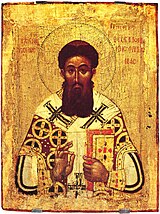Tabor Light

| Part of a series on |
| Palamism |
|---|
 |
|
|
In
As a theological doctrine, the uncreated nature of the Light of Tabor was formulated in the 14th century by
The view was very controversial when it was first proposed, sparking the
In Eastern Orthodoxy
According to the Hesychast mystic tradition of Eastern Orthodox spirituality, a completely purified saint who has attained
Instances of the Uncreated Light are read into the Old Testament by Orthodox Christians, e.g. the
Identification with the fires of hell
Many Orthodox theologians have identified the Tabor light with the fire of
According to Iōannēs Polemēs, Palamas himself did not identify hell-fire with the Tabor light: "Unlike Theophanes, Palamas did not believe that sinners could have an experience of the divine light [...] Nowhere in his works does Palamas seem to adopt Theophanes' view that the light of Tabor is identical with the fire of hell."[14]
Roman Catholicism

Palamism, Gregory Palamas' theology of divine "operations", was never accepted by the Scholastic theologians of the Latin Catholic Church, who maintained a strong view of the simplicity of God, conceived as Actus purus. This doctrinal division reinforced the east–west split of the Great Schism throughout the 15th to 19th centuries, with only Pope John Paul II opening a possibility for reconciliation by expressing his personal respect for the doctrine.
Catholicism traditionally sees the glory manifested at Tabor as symbolic of the eschatological glory of heaven; in a 15th-century Latin hymn Coelestis formam gloriae:
O wondrous type, O vision fair
of glory that the Church shall share
Which Christ upon the mountain shows
where brighter than the sun He glows
With shining face and bright array
Christ deigns to manifest today
What glory shall be theirs above
who joy in God with perfect love.[15]
In popular culture
"Tabor Light" was also used in the popular press of 1938 in reference to a mysterious light seen around a cemetery named "Tabor" near Esterhazy, Saskatchewan, Canada.[21]
See also
References
- ^ John Meyendorff, "Mount Athos in the Fourteenth Century: Spiritual and Intellectual Legacy" in Dumbarton Oaks Papers 1988
- ISBN 978-0-913836-37-8), p. x
- ISBN 0-88141-295-3), pp. 215-216.
- ISBN 0-8386-4111-3), p. 243
- ^ a b "Pope John Paul II 11 August 1996 Angelus". www.ewtn.com. Retrieved 2018-01-09.
- ^ a b Original text (in Italian) Speaking of the hesychast controversy, Pope John Paul II said the term "hesychasm" refers to a practice of prayer marked by deep tranquillity of the spirit intent on contemplating God unceasingly by invoking the name of Jesus. While from a Catholic viewpoint there have been tensions concerning some developments of the practice, the Pope said, there is no denying the goodness of the intention that inspired its defence, which was to stress that man is offered the concrete possibility of uniting himself in his inner heart with God in that profound union of grace known as Theosis, divinization.
- ^ a b The "Luminous Mysteries", published in Rosarium Virginis Mariae, October 2002.
- ISBN 978-9004169654.
- ^ "Jewish and Christian Orthodox Dialogue".
- ^ Chopelas, Peter (2016), "Uncreated Energies", Heaven and Hell in the Afterlife According to the Bible
- ^ Mmetallinos, George (March 2009). "Paradise and hell in the Orthodox tradition". Orthodox Heritage. 7 (3).
- ^ Vlachos, Hierotheos, Life after Death, pp. 254–261
- ^ Polemēs, Iōannēs (1996). Theophanes of Nicaea: His Life and Works. Vol. 20. Verlag der Österreichischen Akademie der Wissenschaften. p. 99.
- ^ Polemēs, Iōannēs (1996). Theophanes of Nicaea: His Life and Works. Vol. 20. Verlag der Österreichischen Akademie der Wissenschaften. p. 100.
- John M. Neale, 1851
- ^ Gregory the Great, Moralia, book 18, 89
- ^ van Ruysbroeck, Jan (1913). The Book of the Twelve Béguines. Translated by Francis, John. London: John M. Watkins. p. 40.
- ISBN 978-0-8091-2447-3.
- ISBN 0-8386-4111-3), p. 243
- ^ "St. Gregory Palamas and the Pope of Rome", Orthodox Tradition Volume XIII, Number 2, Center for Traditionalist Orthodox Studies (1996). "Those who are enlightened by God know Him truly, as did some of the Orthodox Popes of Rome before that Church's fall, but this knowledge is solely the product of union with Christ, both in the case of the pauper and the Pope, as St. Gregory so eloquently argues in his essay Περὶ Θείας καὶ Θεοποιοῦ Μεθέξεως [On Divine and Deifying Participation] (Chrestou, op. cit., Vol. 3, pp. 212-261). The very structure of Palamite theology disallows any attribution of universal jurisdiction or authority, except in the traditional sense of 'honor' and 'eminence,' to anyone in the Church. St. Gregory resolutely and unequivocally identifies true teaching and all authority with spiritual enlightenment, which, in turn, is the product of a true and genuine encounter with God shared by all enlightened individuals in common and equally. Hesychasm is a direct condemnation of Papism." (pp. 26f., emphasis in original)
- ISBN 9780888821775.
Further reading
- Clucas, Lowell (1985). "The Triumph of Mysticism in Byzantium in the Fourteenth Century". In Vryonis, Jr., Speros (ed.). Byzantine Studies in Honor of Milton V. Anastos, Byzantina kai Metabyzantina. Malibu.
- Lossky, Vladimir (1976) [1957]. The Mystical Theology of the Eastern Church. St Vladimir's Seminary Press. ISBN 0-913836-31-1. A translation of Essai Sur la Theologie Mystique de L'Eglise D'Orient (in French). 1944.
- Maloney, George Anthony (1978). A theology of uncreated energies. ISBN 978-0-87462-516-5.
- Papademetriou, George C. (2004). Introduction to St. Gregory Palamas. ISBN 978-1-885652-83-6.
- Meyendorff, John (1959). A Study of Gregory Palamas. Orthodox theological library. Faith Press.
- Andreopoulos, Andreas (2005). Metamorphosis: The Transfiguration in Byzantine Theology and Iconography. St Vladimir's Seminary Press. ISBN 0-88141-295-3.
External links
- Light in Icon Archived 2007-09-28 at the Wayback Machine(Russia-hc.ru)
- The Sunday of St. Gregory Palamas (The Second Sunday of Great and Holy Lent)[permanent dead link] by Benedict Seraphim
- Theoria, Tabor Light (photismos) as Vision

